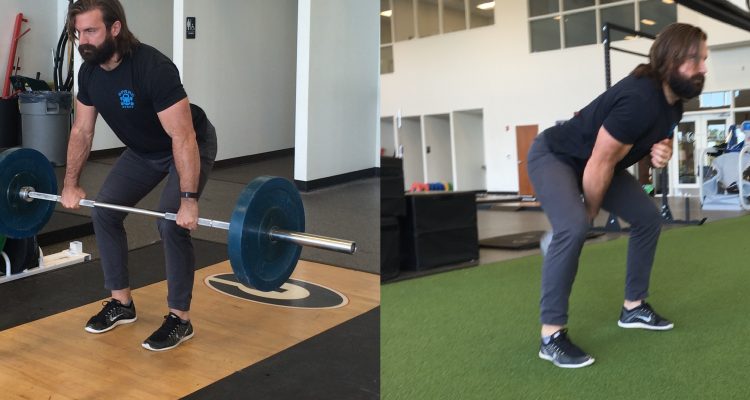Have you ever considered that a movement and an exercise are not the same? If not, that’s OK. There is a lot of mistaken terminology in strength and conditioning, such as the word, “Intensity.” Is intensity the difficulty of a workout, or the load you have on the bar? I’ll save that one for a future rant. Back to the point, movement and exercise are in fact different terms, but the two are married in strength and conditioning. Understanding their relationship can make your training safer and more effective through enabling more exercise variation.
Here are our two keywords defined…
A MOVEMENT is changing your physical position. Movements are the means to accomplishing tasks in life and sport. Here are the basics, or what we like to refer to as the fundamental movements:
- Lower body push (ex. standing up from a chair or sprinting)
- Lower body pull (ex. picking up an object from the floor)
- Upper body push (ex. putting an object on a high shelf)
- Upper body pull (ex. starting a lawnmower)
An EXERCISE is a skill we use to practice expressing movements. They transfer to life and sport by improving our dynamic movements, like running, with strength and quality. Here are examples of how we practice fundamental movements through exercise:
- Lower body push
- Front squat
- Lunge
- Lower body pull
- Deadlift
- Kettlebell swing
- Upper body push
- Push-up
- Bench press
- Upper body pull
- Pull-up
- Row
Often times, movements are alternatively tagged in the gym with exercise names. For example, the lower body push is often referred to as a squat or lunge, or the upper body push as a press. Suddenly, MOVEMENTS and EXERCISES are confused. Don’t let that happen! If you lose sight of the movement behind each exercise, you lose the point of each exercise and leave yourself with a long list of new things to learn each time your program changes. Always look to identify the fundamental movement behind each exercise you perform.
Here’s what I mean. There are standard rules for performing the fundamental movements properly that can be applied to the various exercises you use to express them. The rules really offer differentiation between movements, as well as safety guidelines. With that in mind, you can incorporate variation into your programming by interchanging new exercises and also spend minimal time learning new mechanics. You should easily understand the basic mechanics of any exercise through identifying the movement that is mimicked and grasping the principles of the movement.
Here’s how two related exercises can be practiced by applying upper body push rules. Let’s say you are enhancing your strength through a push-up. You should keep your shoulders lowered with lat and trap tension and brace your whole core to stabilize your spine as you drive your hands into the floor raising your body. Before time and repetition stagnate your progress in improving the upper body push, you can vary training by laying down on a bench with dumbbells or a barbell in your hands and practice the same movement through the bench press. Same rules apply — keep tension in your lats and traps to protect your shoulders and isolate your chest muscles, brace your whole core, and drive your hands into the weights to raise them.
Follow suit for for the rest of the movements and related exercises. If you understand lower body pushing you can incorporate variations of squats or lunges. You can use a variety of hip dominant, hinging exercises to do lower body pulls, such as deadlifts or kettlebell swings. The differences in exercise variations are subtle and easily learned if you can identify the main points and rules of the movements they enhance!
Take action by selecting a highly functional exercise example of each movement and master the skills. From there you will be ready to incorporate variation safely and effectively with new exercises. Your progress will surge forward consistently, and the results will be unprecedented for you.
I recommend these exercise expressions of the fundamental movements to get started:
- Lower body push - Kettlebell goblet or barbell front squat
- Lower body pull - Kettlebell sumo or barbell deadlift
- Upper body push - Push-up (elevate your hands if you lack the strength for a standard push-up)
- Upper body pull - Pull-up (or an inverted row if you lack the strength for a pull-up)
By: Fred Munzenmaier

